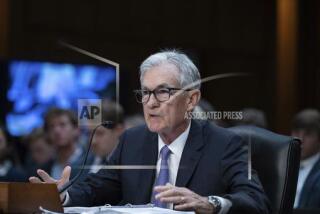Greenspan Was Right After All
Alan Greenspan goes to Capitol Hill today to say, “I told you so.”
In testimony before the Senate today and the House on Wednesday, the Federal Reserve Board chairman will deliver his semiannual report on the U.S. economy. And finally, statistics are bearing out what Greenspan has been predicting for some time: A significant slowdown in business activity is underway, owing in part to Asia’s economic plunge.
“He’ll take the opportunity to point out that the Asian crisis has in fact slowed growth,” said Chris Varvares, president of Macroeconomic Advisers in St. Louis. “Indirectly, he’ll give himself a pat on the back for having held policy steady while the Fed waited for the situation in Asia to shake out.”
The Fed chairman is scheduled to deliver his legally mandated Humphrey-Hawkins testimony to the Senate Banking Committee today at 10:15 a.m. EDT. He will repeat the report to the House Banking Committee on Wednesday at 9:30 a.m.
Greenspan has been fighting off Fed “hawks” who have been pushing since last year to raise the Fed’s benchmark short-term interest rate, now 5.5%, to cool what has been a red-hot U.S. economy.
In May, two of the most outspoken traditionalists on the Fed’s policymaking Federal Open Market Committee voted for a rate rise, arguing the economy was about to spin out of control and needed tighter credit to rein in growth.
*
But that was then and this is now. Fed officials acknowledge they are now dealing with a completely different economy--one that has finally begun to feel the pain of lower exports to and higher imports from crisis-ridden Asia.
Both factors make for reduced production at home that some say could even have caused the economy to shrink in the second quarter--difficult as that might be to believe, with consumers still spending freely.
“The point is that the economy will be slowing down and that will constrain the central bank from raising rates,” said Anthony Chan, chief economist at Columbus, Ohio-based Banc One Investment Advisors Corp. “Greenspan really deserves kudos for recognizing how much of an impact Asia would have on the U.S. economy.”
Major vindication for Greenspan came last week, when the government reported a stunning 10.3% surge in the U.S. trade deficit to $15.75 billion in May. Combined with a drop in business inventories, suggesting that businesses are selling stocked-up goods rather than producing new ones, the data prompted many economists to slash their forecast for economic growth in the second quarter.
A first official estimate of growth won’t be released until July 31, but already some observers think growth has actually been negative. That’s in stark contrast to the first quarter, when the economy expanded at a fiery 5.4% rate.
The $7-trillion-plus U.S. economy can easily take a few hits. Consumers are more confident about their future than they have been at any point in the past three decades, not least because of sky-high stock prices that have boosted personal wealth.
“This is basically a very solid economy that looks as though it’s going to slow down all by itself,” said Barry Bosworth, an economist at the Brookings Institution.
That is exactly what Greenspan, always careful not to rock the boat, has been arguing.
Of course, evidence of a slowdown or even a possible contraction in the U.S. economy is sure to prompt renewed calls by some lawmakers for an interest rate cut by the Fed.
Not that Greenspan is likely to heed those demands. The central bank chief who in December 1996 rocked world markets by questioning whether Wall Street had a case of “irrational exuberance” is well aware that any rate cut now could push already dangerously high-priced stock and bond markets to even more lofty heights.
“I hope that he does not go so far as to give a misleading impression that the Fed is leaning toward easing,” Varvares said.
More to Read
Inside the business of entertainment
The Wide Shot brings you news, analysis and insights on everything from streaming wars to production — and what it all means for the future.
You may occasionally receive promotional content from the Los Angeles Times.










